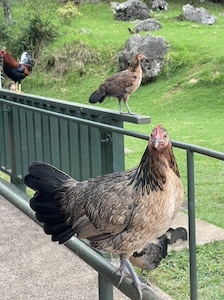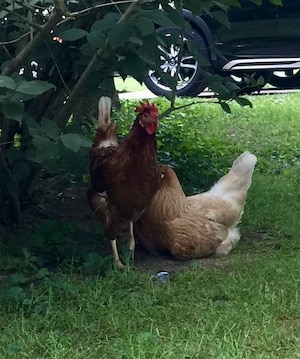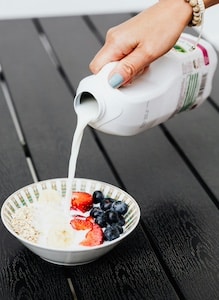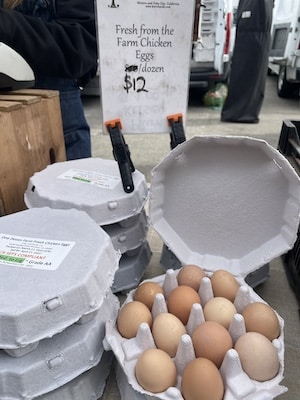Amid the headlines of the ever-changing bird flu outbreaks in chickens1 and now, the spread to dairy cattle, one headline is still consistent: our food is safe. Poultry producers and dairy farmers work to ensure their products are safe by following safety protocols and regulations. State and federal food and health agencies provide due diligence in protecting and testing meat, eggs and milk before it goes into the food supply. Hence why we see the headlines, especially those that focus on larger operations.

Wild chickens on Kona, Hawaii
However, the size of chicken flocks or dairies does not, or should not, alter proper handling of food-producing animals and their products. Recent news about salmonella outbreaks in backyard chickens reflects that fact. While small flocks of chickens or local distribution of milk, especially raw, may not have the same federal regulations, proper handling from the producer to our table is everyone’s responsibility.
The final grade for any food producers — big or small —is passing the test of food safety and providing the assurance of safe food at the roadside market or grocery shelf.
Birds Got to Fly …
“Birds got to fly … and virus got to spread” is the not the exact phase in a popular Broadway song, but it does describe our current situation. Avian or bird flu continues to create economic woes for farmers in several U.S. states and the trend is not expected to change in the near future.
Over the past 3 months, bird flu viruses have been detected in dairy herds in a few states.2 Data collected through the farms’ technology systems, in cooperation with veterinary labs at Cornell and Iowa State, were able to pinpoint bird flu as the cause of the sick cows. Animal experts are not surprised as infected migratory birds, like geese, can spread viruses through their secretions and feces to “barn” birds such as blackbirds, increasing exposure to farm animals. In fact, the illness of barn cats became a clue to discovering the virus transmission.3
People rarely get bird flu virus infection, but it can happen with long term close and unprotected contact (no gloves or other protective wear) with infected birds or other animals.
While bird flu has been the topic of most headlines, especially in agricultural-related newsfeeds, the Centers for Disease Control (CDC) released an alert late last month that over 100 people in 29 states, with a third requiring hospitalization, had become ill from salmonella due to the care or touching of backyard chickens.4
Big or Small — Safety First
 While the thought of free-range chickens is appealing to some, controlling viruses like bird flu is better in indoors, keeping poultry separated from migratory birds. In addition, large poultry farmers follow strict biosecurity measures,5 some of which I’ve experienced when visiting a family-owned commercial chicken farm. Visitors are limited and anyone entering the chicken facilities must wear protective clothing from head to toe. Employers usually are required to shower in and out of barns. Also, all barns and equipment are continuously disinfected.
While the thought of free-range chickens is appealing to some, controlling viruses like bird flu is better in indoors, keeping poultry separated from migratory birds. In addition, large poultry farmers follow strict biosecurity measures,5 some of which I’ve experienced when visiting a family-owned commercial chicken farm. Visitors are limited and anyone entering the chicken facilities must wear protective clothing from head to toe. Employers usually are required to shower in and out of barns. Also, all barns and equipment are continuously disinfected.
While backyard chickens may seem like pets, they are not. Chickens do carry salmonella germs which can spread wherever chickens are. Even though strict biosecurity measures are not required, the basic principles of hand washing, using specific footwear for poultry areas and cleaning eggs before using are essential. One local farmer who raises chicken for his roadside market states that every time they move chickens from one pasture to the next, protective shoe coverings are used to prevent cross contamination and eggs are cleaned before selling to the public.
What About the Milk?

The only warning health officials have issued about milk or poultry product is advice not to drink raw milk or eat raw milk-based cheese. While current testing of raw milk is limited, pasteurization is believed to kill any potential existing virus in the milk. There is a reason Louis Pasteur, the French chemist became famous.
The Final Grade
Keeping poultry, eggs or milk at a food safe “Grade A “is a collaborative effect of the farmer, health officials and the consumer. To limit any concerns, consumers should follow these basic guidelines.
- Cook poultry, ground meats and eggs to an internal temperature of 165 degrees Fahrenheit. Yes, use a thermometer! That internal temperature will kill any bacteria and viruses, including bird flu viruses.
- Limit or avoid raw milk or raw milk cheese. If raw milk items are preferred, know your source or consider home pasteurization of milk.
- If buying unrefrigerated eggs at a local market, wash your eggs before using. Grocery store eggs have been cleaned and washed, hence the need for refrigeration.
- The FDA recommends that the dairy industry refrain from selling raw milk or raw/unpasteurized cheese products made from milk from cows showing signs of illness.
- People are advised to properly handle and cook meat to an internal temperature of at least 165°F. This includes any meat used to feed pets.
Keeping Food Safe is always the “passing grade” from the farm to the table!
References
1. “The ongoing bird flu outbreak in the United States,” Reuters, May 30, 2024.
2. “Clues from bird flu’s ground zero on dairy farms in the Texas panhandle,” by Amy Maxmen, KFF Health News, May 24, 2024.
3. “Avian Flu Virus Is Spreading And Has Been Found In Raw Milk From Infected Cows. Should We Be Concerned?” By Henry I. Miller, MS, MD and Kathleen L. Hefferon, The American Council on Science and Health, April 30, 2024.
4. “CDC warns of Salmonella outbreaks linked to backyard poultry flocks,” U.S. Department of Health & Human Services Centers for Disease Control, May 23, 2024.
5. “Should I be Worried About Bird Flu?” by Teresa Bjork, American Farm Bureau Federation, April 5, 2023.

